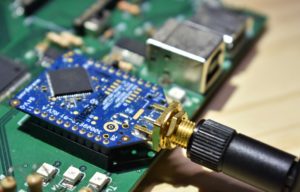Bee Smart
Before buying an expensive transceiver, prototype with a cheaper one first, like with this Xbee module. You can easily setup a wireless channel and test your algorithms.
Last updated March 2019
It’s called a prototype for a reason. It’s not for public release, so it doesn’t have to be perfect. You don’t want it to cost thousands of dollars and take months to build. You need something quick for proof-of-concept and to be able to showcase your idea.

Origin
This Twin Insight stems from one of our previous projects – a weather balloon. We were looking at purchasing a transceiver to establish half-duplex communication between our ground station and the weather balloon during flight. When we say expensive, it’s all relative. The transceiver we were looking at was a couple hundred dollars, while an Xbee module for under $50. A transceiver for an airplane, satellite, or spacecraft can cost thousands of dollars.
Deciding Factors
We decided not to buy the more expensive transceiver and settled on the Xbee. Why? Three reasons: 1) cost, as mentioned above, 2) lead time, and 3) change in design requirements. The lead time for the transceiver was 6-8 weeks – the Xbee was readily available. We couldn’t afford to wait 6-8 weeks since the project was due in 8 weeks. We also decided not to fly the balloon due to the added cost of the balloon, helium, and parachute, and the extra qualifications needed to adhere to FCC (Federal Communications Commission) and FAA (Federal Aviation Administration) regulations. If we were to purchase the more expensive transceiver, it would have been a waste of money. Sometimes you can’t even return electronics, so a refund would have been dubious.
No Factors
Let’s say that the lead time, cost, and revised design requirements weren’t a factor. It still would have been a good idea to buy the cheaper transceiver. This would allow you to test parts of your design such as the software. You could make sure that your data is being packeted correctly on the weather balloon and you could verify that your ground station is able to parse and display the data. I don’t think you want to wait until you get the other transceiver to test that functionality.
Another Example
How about another example? Great, I’m glad you asked. We’re doing some image processing on an embedded platform. We want to make sure that we can process 1 frame per second (fps) and upload each image to a database. Do we need to purchase an expensive camera? No, we just need a camera that can take images or video of at least 1 FPS, which is about every camera today. It might not be the same interface (USB, HDMI, CameraLink) that you plan to use in your final product, but at least you can verify some parts of your design.
What did we learn?
Try to find cheaper modules to prototype with, then upgrade to the more expensive module for your final product.
Verify your design as much as you can while you wait on the inevitable lead times of expensive hardware.